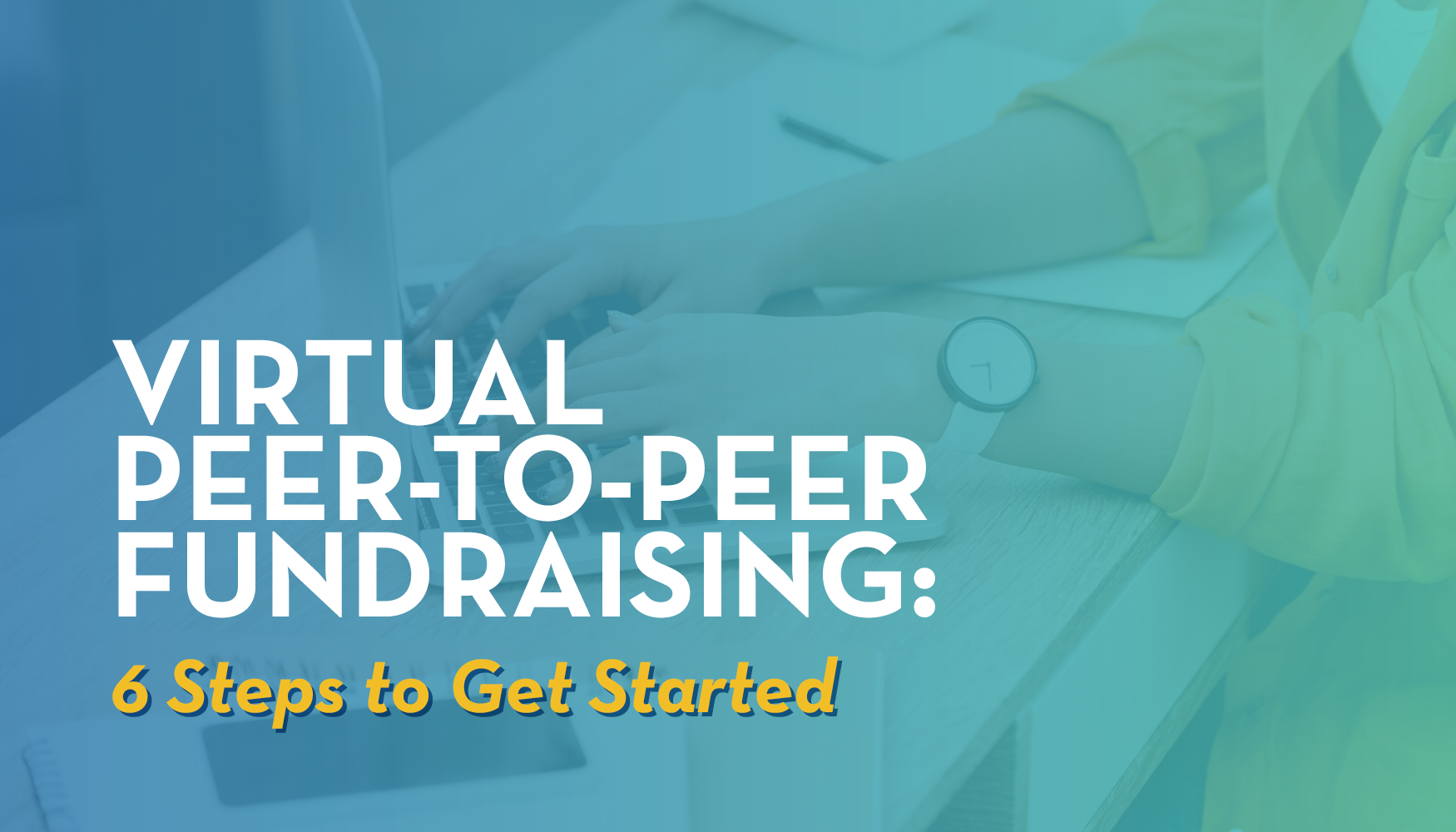Online fundraising campaigns present a valuable opportunity for nonprofits to connect with a larger audience and engage them in a new and exciting way. One of the best ways to get started is through a peer-to-peer fundraising program, where you enlist loyal supporters to garner donations on your organization’s behalf.
With the right strategies and resources, nonprofits of all sizes can grow their support base with virtual peer-to-peer fundraising. This is a great tactic to tie together donor engagement strategies, online fundraising tactics, and virtual events in one supercharged campaign.
If you’re unsure where to start, we’ll guide you through virtual peer-to-peer fundraising and all the steps you need to get started. Let’s dive right in!
1. Determine your virtual peer-to-peer campaign’s goals and structure.
As with any nonprofit event or campaign, setting initial guidelines at the start will keep your plans focused on your core goals while preserving time and resources. Your goals for a virtual peer-to-peer fundraising campaign should include revenue, recruitment, and donor engagement.
Whenever possible, tie your goals to a concrete key performance indicator (KPI) like these:
- Target revenue
- Cost-per-dollar raised or return on investment (ROI)
- New donor acquisition
- New campaign participants
- Past donor retention
- Online engagement, like traffic volume or social shares
Additionally, think about the structure of your virtual peer-to-peer campaign, as there’s lots of flexibility within the tactic. Consider these questions as you begin outlining your campaign:
- Will you allow any and all supporters to launch individual giving pages?
- Or, will you recruit and train a smaller group of volunteers or ambassadors instead?
- Will you incorporate virtual events into your campaign?
- If so, what will the events be? When will they occur?
Many nonprofits have turned to virtual peer-to-peer fundraising as an effective way to generate support leading up to a major online event, like a virtual auction or gala. Pairing virtual events with peer-to-peer tactics can help maximize their impact, so it’s important to determine the campaign’s schedule of events at the start of the planning process.
2. Start the planning process early.
Any type of complex campaign requires plenty of planning to succeed, and this is especially true of peer-to-peer fundraising that might incorporate virtual events and new platforms. Start several months in advance of launch day to give yourself plenty of time.
We recommend forming dedicated teams to handle specific tasks rather than having an individual handle everything. At a minimum, you’ll need to form these two teams:
- Campaign team, which will plan and oversee the longer peer-to-peer fundraising campaign
- Event team, which will plan and direct the virtual events that are part of the broader campaign
Depending on the scale of your campaign and events, splitting up the work even further will likely be a smart move. Additional teams can be assigned to specific tasks like:
- Marketing the campaign and events
- Recruiting, training, and managing volunteer fundraisers
- Overseeing and configuring the needed technology
- Securing sponsorships and matching gifts
- Handling specific elements of your event, like procuring the right range of auction items for a virtual auction and gala
If you’ve ever planned a complex event like an annual gala, you know that they have a lot of moving parts that can easily become overwhelming. Sharing the workload and getting started as early as possible can make a big difference. You can also seek external support during the planning process to ensure everything runs as smoothly as possible.
3. Invest in the right tools.
For a large-scale virtual peer-to-peer fundraising campaign, make sure your team has the right tools for the job. These include:
- Peer-to-peer fundraising tools that make it easy to create individual giving pages and track progress toward your campaign’s goals.
- Event-specific software as needed for your campaign events, like online auction software to help you create an item catalog, price your items, and process bids
- Live-streaming software to host your virtual events and check-ins with fundraisers
- A constituent relationship management system (CRM) integrated with your fundraising software to receive the engagement and donation data generated by the campaign
- Marketing software, like social media and email management tools
The right solution will check all these boxes, including peer-to-peer fundraising, event management, marketing and communications, and more. Ideally, this will all be integrated with your CRM for seamless reporting and analysis, saving you time and the cost of purchasing multiple tools. If you’re uncertain which solution will help you the most, check out the OneCause guide to the best peer-to-peer fundraising platforms for the top picks.
Purchasing technology is an investment in your nonprofit’s ability to grow and adapt. A well-planned peer-to-peer fundraising campaign can be extremely effective at raising support and strengthening your ties with donors, so it pays to expand your toolkit when necessary.
4. Recruit volunteer fundraisers.
There are two general approaches you might take to recruiting volunteer fundraisers for your campaign:
- DIY-style. This approach allows any supporter to create their personalized donation page, set their goal, and promote it on social media. This is effective for more general online fundraising campaigns.
- Ambassador style. This method takes a much more strategic approach and is a smart choice for campaigns leading up to a major event that you’ve invested time and resources in planning. Recruit a smaller team of ambassadors from well-connected and dedicated supporters in your community and empower them to tap into their networks to help reach fundraising goals.
With either tactic, you’ll need to provide your volunteers with guidance and resources to help them reach their goals. Videos explaining your campaign and templates for emails or social media posts are easy examples. For a DIY-style campaign, create a dedicated library of resources that fundraisers can access. For ambassadors, take a more one-on-one approach and regularly check in to support them.
To help you get started, explore the OneCause guide to Creating an Ambassador Toolkit.
5. Gamify the experience.
To maximize engagement with your peer-to-peer fundraising campaign, you’ll need to actively incentivize it! Consider these strategies for adding an element of friendly competition:
- Set specific fundraising or event registration goals for your fundraisers or ambassadors.
- Offer prizes and recognition to top volunteers during your campaign’s final event with an awards ceremony.
- Create a viral challenge or unique hashtag for supporters to post their own stories or photos, then choose a handful of winners to shout out or receive a prize.
- Set a challenge period of 24 hours for your fundraisers to compete to collect the most donations.
- Use leaderboards and fundraising thermometers on your campaign pages to track progress and drive energy toward your goal.
To boost the energy and results of your campaign, incorporate engagement and gamification tactics like these into your planning process from the start. Combined with plenty of support and communication with your volunteer fundraisers, these tactics can make a big difference and boost your results. More energy means more donations and registrations for your event!
6. Promote your campaign and events.
Finally, think about how you will promote your virtual peer-to-peer campaign and events. Although your volunteer fundraisers or ambassadors will be spreading the word on your behalf, don’t leave it completely to them. An active approach to marketing your campaign will only generate more interest among supporters.
Use a multichannel strategy to promote your peer-to-peer campaign and related virtual events. This means using each of your marketing channels to direct readers further towards taking a specific target action, in this case making a donation or registering for your event. Use marketing channels like:
- Email blasts and invitations to segments of your contact list
- Your organization’s social media profiles
- Direct mail invitations or your email newsletter
- Your campaign page on your website, or your event’s dedicated microsite
- Any event-specific digital materials, like your online auction item catalog
Leverage these resources to get the word out about your campaign and motivate readers to get involved. Direct your audience towards making a donation or registering by encouraging deeper engagement, like clicking through from your social media posts to your campaign’s web page. Then, make sure it’s very clear what you want readers to do and that the donation or registration process is simple and fast.
If want to dig a little deeper, Deep Sync recommends taking a data-driven approach to your promotional strategy. Take a look at your previous marketing data and analyze it for key insights. You may discover certain supporter groups that are more likely to respond to peer-to-peer fundraising appeals, allowing you to direct your attention to marketing to them.
A solid infrastructure of virtual tools and strategies combining fundraising, engagement, and event elements will serve as a strong foundation for any nonprofit campaign. Don’t be afraid to hone your skills and tap into your virtual audience—you may be surprised by the level of support you receive from peer-to-peer and other virtual activities!
Originally published in September 2020. Updated August 2024.


Comments
Questions or comments? Join the conversation!